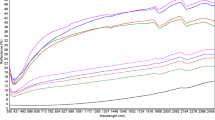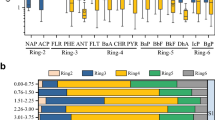Abstract
Purpose
Combined pollution by polycyclic aromatic hydrocarbons (PAHs) and heavy metals are commonly found in industrial soils. This study aims to investigate the effect of the coexistence of heavy metals on the sorption of PAHs to soils. We focused specifically on the relationship of the sorption capacity with the estimation of the binding energy between PAHs and heavy metals.
Materials and methods
The sorption of typical PAHs (naphthalene, phenanthrene, and pyrene) to soils coexisting with heavy metals (Cu(II), Pb(II), and Cr(III)) was characterized in batch sorption experiments. The binding energy between PAHs and heavy metals in aqueous solution was estimated by quantum mechanical (QM) method using density functional theory (DFT) at the M06-2x/def2svp level of theory.
Results and discussion
Sorption capacity and nonlinearity of the PAHs to the soils were enhanced by the coexisting heavy metals. The extent of increment was positively associated with the hydrophobicity of the PAHs and the electronegativity and radius of the metal cations: Cr(III) > Pb(II) > Cu(II). The cation-π interaction was revealed as an important noncovalent binding force. There was a high correlation between the binding energies of the PAHs and K f ′ (K f adjusted after normalizing the equilibrium concentration (C e) by the aqueous solubility (C s)) (R 2 > 0.906), indicating the significant role of the cation-π interactions to the improved PAH sorption to soils.
Conclusions
In the presence of heavy metals, the sorption capacities of naphthalene, phenanthrene, and pyrene to soils were enhanced by 21.1–107 %. The improved sorption capacity was largely contributed from the potent interactions between PAHs and heavy metals.





Similar content being viewed by others
References
Abel S, Nehls T, Mekiffer B, Wessolek G (2015) Heavy metals and benzo[a]pyrene in soils from construction and demolition rubble. J Soils Sediments 15:1771–1780
Alternatives NRCC (1994) Alternatives for ground water cleanup. National Academies Press
Barone V, Cossi M (1998) Quantum calculation of molecular energies and energy gradients in solution by a conductor solvent model. J Phys Chem A 102:1995–2001
Braida WJ, White JC, Ferrandino FJ, Pignatello JJ (2001) Effect of solute concentration on sorption of polyaromatic hydrocarbons in soil: Uptake rates. Environ Sci Technol 35:2765–2772
Cabaniss SE (2009) Forward modeling of metal complexation by NOM: I. A priori prediction of conditional constants andspeciation. Environ Sci Technol 43:2838–2844
Cabaniss SE (2011) Forward modeling of metal complexation by NOM: II. Prediction of binding site properties. Environ Sci Technol 45:3202–3209
Carmo AM, Hundal LS, Thompson ML (2000) Sorption of hydrophobic organic compounds by soil materials: application of unit equivalent Freundlich coefficients. Environ Sci Technol 34:4363–4369
Chen J, Zhu D, Sun C (2007) Effect of heavy metals on the sorption of hydrophobic organic compounds to wood charcoal. Environ Sci Technol 41:2536–2541
Chiou C, Peters LJ, Freed VH (1979) A physical concept of soil-water equilibria for nonionic organic compounds. Science 206:831–832
Chiou C, Porter PE, Schmedding DW (1983) Partition equilibriums of nonionic organic compounds between soil organic matter and water. Environ Sci Technol 17:227–231
Delle Site A (2001) Factors affecting sorption of organic compounds in natural sorbent/water systems and sorption coefficients for selected pollutants. A review J Phys Chem Ref Data 30:187–439
Feng X, Simpson AJ, Simpson MJ (2006) Investigating the role of mineral-bound humic acid in phenanthrene sorption. Environ Sci Technol 40:3260–3266
Frisch MJ, Trucks GW, Schlegel HB, Scuseria GE, Robb MA, Cheeseman JR, Scalmani G, Barone V, Mennucci B, Petersson GA (2009) Gaussian 09, Revision D. 01; Gaussian: Wallingford, CT, USA
Gao Y, Xiong W, Ling W, Xu J (2006) Sorption of phenanthrene by soils contaminated with heavy metals. Chemosphere 65:1355–1361
Grimme S (2006) Semiempirical GGA-type density functional constructed with a long-range dispersion correction. J Comput Chem 27:1787–1799
Huang W, Weber WJ (1997) A distributed reactivity model for sorption by soils and sediments. 10. Relationships between desorption, hysteresis, and the chemical characteristics of organic domains. Environ Sci Technol 31:2562–2569
Huang W, Young TM, Schlautman MA, Yu H, Weber WJ (1997) A distributed reactivity model for sorption by soils and sediments. 9. General isotherm nonlinearity and applicability of the dual reactive domain model. Environ Sci Technol 31:1703–1710
Keiluweit M, Kleber M (2009) Molecular-level interactions in soils and sediments: the role of aromatic π-systems. Environ Sci Technol 43:3421–3429
Khan S, Cao Q (2012) Human health risk due to consumption of vegetables contaminated with carcinogenic polycyclic aromatic hydrocarbons. J Soils Sediments 12:178–184
LeBoeuf EJ, Weber WJ (1997) A distributed reactivity model for sorption by soils and sediments. 8. Sorbent organic domains: discovery of a humic acid glass transition and an argument for a polymer-based model. Environ Sci Technol 31:1697–1702
Lin D, Tu Y, Zhu L (2005) Concentrations and health risk of polycyclic aromatic hydrocarbons in tea. Food Chem Toxicol 43:41–48
Liu Z, Guo H, He H, Sun C (2012) Sorption and cosorption of the nonionic herbicide mefenacet and heavy metals on soil and its components. J Environ Sci-China 24:427–434
Lu R (2000) Analysis methods of soil agricultural chemistry. China Agricultural Science and Technology Publishing House (in Chinese)
Lu Y, Pignatello JJ (2004) Sorption of apolar aromatic compounds to soil humic acid particles affected by aluminum (III) ion cross-linking. J Environ Qual 33:1314–1321
Luo L, Zhang S, Shan X, Jiang W, Zhu Y, Liu T, Xie Y, McLaren RG (2006) Arsenate sorption on two Chinese red soils evaluated with macroscopic measurements and extended X-ray absorption fine-structure spectroscopy. Environ Toxicol Chem 25:3118–3124
Luo L, Zhang S, Ma Y, Christie P, Huang H (2008) Facilitating effects of metal cations on phenanthrene sorption in soils. Environ Sci Technol 42:2414–2419
Luo L, Zhang S, Christie P (2010) New insights into the influence of heavy metals on phenanthrene sorption in soils. Environ Sci Technol 44:7846–7851
Ma J, Dougherty DA (1997) The Cation-π interaction. Chem Rev 97:1303–1324
Mahadevi AS, Sastry GN (2013) Cation-π interaction: its role and relevance in chemistry, biology, and material science. Chem Rev 113:2100–2138
Pei Z, Yang S, Li L, Li C, Zhang S, Shan X, Wen B, Guo B (2014) Effects of copper and aluminum on the adsorption of sulfathiazole and tylosin on peat and soil. Environ Pollut 184:579–585
Ping L, Luo Y, Wu L, Qian W, Song J, Christie P (2006) Phenanthrene adsorption by soils treated with humic substances under different pH and temperature conditions. Environ Geochem Hlth 28:189–195
Qu X, Wang X, Zhu D (2007) The partitioning of PAHs to egg phospholipids facilitated by copper and proton binding via cation-π interactions. Environ Sci Technol 41:8321–8327
Qu X, Liu P, Zhu D (2008) Enhanced sorption of polycyclic aromatic hydrocarbons to tetra-alkyl ammonium modified smectites via cation-π interactions. Environ Sci Technol 42:1109–1116
Rafatullah M, Sulaiman O, Hashim R, Ahmad A (2009) Adsorption of copper (II), chromium (III), nickel (II) and lead (II) ions from aqueous solutions by meranti sawdust. J Hazard Mater 170:969–977
Tokalioǧlu Ş, Kartal Ş, Elci L (2000) Determination of heavy metals and their speciation in lake sediments by flame atomic absorption spectrometry after a four-stage sequential extraction procedure. Anal Chim Acta 413:33–40
Vácha R, Skála J, Čechmánková J, Horváthová V, Hladík J (2015) Toxic elements and persistent organic pollutants derived from industrial emissions in agricultural soils of the Northern Czech Republic. J Soils Sediments 15:1813–1824
Wang X, Sato T, Xing B (2005) Sorption and displacement of pyrene in soils and sediments. Environ Sci Technol 39:8712–8718
Xiao L, Qu X, Zhu D (2007) Biosorption of nonpolar hydrophobic organic compounds to Escherichia coli facilitated by metal and proton surface binding. Environ Sci Technol 41:2750–2755
Xing B (2001) Sorption of naphthalene and phenanthrene by soil humic acids. Environ Pollut 111:303–309
Xing B, Chen Z (1999) Spectroscopic evidence for condensed domains in soil organic matter. Soil Sci 164:40–47
Xing B, Pignatello JJ (1997) Dual-mode sorption of low-polarity compounds in glassy poly (vinyl chloride) and soil organic matter. Environ Sci Technol 31:792–799
Yang Y, Ratte D, Smets BF, Pignatello JJ, Grasso D (2001) Mobilization of soil organic matter by complexing agents and implications for polycyclic aromatic hydrocarbon desorption. Chemosphere 43:1013–1021
Yuan G, Xing B (2001) Effects of metal cations on sorption and desorption of organic compounds in humic acids. Soil Sci 166:107–115
Zhang W, Zhuang L, Yuan Y, Tong L, Tsang D (2011) Enhancement of phenanthrene adsorption on a clayey soil and clay minerals by coexisting lead or cadmium. Chemosphere 83:302–310
Zhang W, Wu Y, Simonnot MO (2012) Soil contamination due to e-waste disposal and recycling activities: a review with special focus on China. Pedosphere 22:434–455
Zhang W, Zheng J, Zheng P, Tsang DC, Qiu R (2015) The roles of humic substances in the interactions of phenanthrene and heavy metals on the bentonite surface. J Soils Sediments 15:1463–1472
Zhao Y, Truhlar DG (2008) The M06 suite of density functionals for main group thermochemistry, thermochemical kinetics, noncovalent interactions, excited states, and transition elements: two new functionals and systematic testing of four M06-class functionals and 12 other functionals. Theor Chem Acc 120:215–241
Zhao D, Pignatello JJ, White JC, Braida W, Ferrandino F (2001) Dual-mode modeling of competitive and concentration-dependent sorption and desorption kinetics of polycyclic aromatic hydrocarbons in soils. Water Resour Res 37:2205–2212
Zheng T, Ran Y, Chen L (2014) Polycyclic aromatic hydrocarbons (PAHs) in rural soils of Dongjiang River Basin: occurrence, source apportionment, and potential human health risk. J Soils Sediments 14:110–120
Zhong Y, Zhu L (2013) Distribution, input pathway and soil-air exchange of polycyclic aromatic hydrocarbons in Banshan Industry Park, China. Sci Total Environ 444:177–182
Zhou Y, Liu R, Tang H (2004) Sorption interaction of phenanthrene with soil and sediment of different particle sizes and in various CaCl2 solutions. J Colloid Interf Sci 270:37–46
Zhu D, Hyun S, Pignatello JJ, Lee LS (2004a) Evidence for π-π electron donor-acceptor interactions between π-donor aromatic compounds and π-acceptor sites in soil organic matter through pH effects on sorption. Environ Sci Technol 38:4361–4368
Zhu D, Herbert BE, Schlautman MA, Carraway ER, Hur J (2004b) Cation-π bonding: a new perspective on the sorption of polycyclic aromatic hydrocarbons to mineral surfaces. J Environ Qual 33:1322–1330
Acknowledgments
This project was financially supported by the National Key Basic Research Program of China (no. 2014CB41106) and the National Natural Science Foundation of China (no. 21137003).
Author information
Authors and Affiliations
Corresponding author
Additional information
Responsible editor: Jan Schwarzbauer
Electronic supplementary material
Below is the link to the electronic supplementary material.
ESM 1
(DOCX 429 kb)
Rights and permissions
About this article
Cite this article
Liang, X., Zhu, L. & Zhuang, S. Sorption of polycyclic aromatic hydrocarbons to soils enhanced by heavy metals: perspective of molecular interactions. J Soils Sediments 16, 1509–1518 (2016). https://doi.org/10.1007/s11368-015-1341-x
Received:
Accepted:
Published:
Issue Date:
DOI: https://doi.org/10.1007/s11368-015-1341-x




